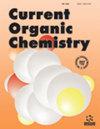比较微波辅助合成法和 Steglich 硫代酯化法对纳米管的改性作用
IF 2.1
3区 化学
Q3 CHEMISTRY, ORGANIC
引用次数: 0
摘要
有机改性碳纳米管最近引起了许多研究小组的兴趣。新一代有机改性碳纳米管在许多技术领域的应用潜力揭示了纳米管共价改性的重要性。本研究采用微波合成法,通过硫酯化反应获得了多壁碳纳米管(MWCNT)噻吩酚衍生物。为此,通过氧化从 MWCNT 得到 MWCNT-COOH,再从 MWCNT-COOH 合成 MWCNTCOCl。从 MWCNT-COCl 开始,通过微波合成法和 MWCNT-COOH 的 Steglich 酯化反应,合成了 MWCNT-CO-S-(正/偏/副甲基/甲氧基苯基)(MA1-MA6)化合物。使用傅立叶变换红外光谱(FTIR)、核磁共振(NMR)、热重分析(TGA)和透射电子显微镜(TEM)方法对产品进行了表征。此外,还比较了所得分子 MA1-MA6 的步骤数、反应时间和温度。研究发现,斯蒂格里奇酯化法是制造这些化合物的最有效技术。研究了 MWCNT、MWCNT-COOH 和 MA1-MA6 化合物的光致发光特性。研究发现,光致发光(PL)的强度随官能团的位置而变化。据检测,MA2 化合物的光致发光强度最高(6.9x102 a.u.),而 MA1 化合物的光致发光强度次之(6.9x102 a.u.)。MA1 和 MA2 在 475-490 nm 的低波长下辐射,具有较高的 PL 值。可能的转变是 nàπ* 转变,由于甲氧基中含有氧原子,因此获得了较高的 PL 值。预计这些材料将用于在高温下工作的成像设备,特别是因为含有甲氧基的结构具有良好的光致发光特性。本文章由计算机程序翻译,如有差异,请以英文原文为准。
Comparison of Microwave-assisted Synthesis and Steglich Thioesterification for the Modification of Nanotubes
Organo-modified carbon nanotubes have recently gained the interest of many research groups. The potential for applying a new generation of organo-modified carbon nanotubes in many technological fields reveals the importance of covalent modifications on nanotubes. In this study, using the microwave synthesis method, multi-walled carbon nanotube (MWCNT) thiophenol derivatives were obtained with a thioesterification reaction. For this purpose, MWCNT-COOH was obtained from MWCNT by oxidation, and MWCNTCOCl was synthesized from MWCNT-COOH. The MWCNT-CO-S-(ortho/meta/para-methyl/methoxyphenyl) (MA1-MA6) compounds were synthesized through both microwave synthesis methods starting with MWCNT-COCl and Steglich ester reaction of MWCNT-COOH. Products were characterized using Fourier Transform-Infrared Spectroscopy (FTIR), Nuclear Magnetic Resonance (NMR), Thermogravimetric Analysis (TGA), and Transmission Electron Spectroscopy (TEM) methods. Furthermore, step numbers, reaction times, and temperatures of obtained molecules, MA1–MA6, were compared. Steglich esterification was found to be the most effective technique for creating these compounds. The photoluminescent characteristics of MWCNT, MWCNT-COOH, and MA1-MA6 compounds were examined. The intensity of the photoluminescence (PL) was found to vary with the location of the functional group. It was detected that the MA2 compound had the highest photoluminescence intensity (6.9x102 a.u.), while the MA1 compound had the second-highest photoluminescence intensity (6.9x102 a.u.). MA1 and MA2 were radiated at low wavelengths of 475–490 nm with high PL values. Possible transitions were nàπ* transitions, with high PL values obtained because of the oxygen atom in the methoxy group. It is expected that these materials will find use in imaging devices operating at high temperatures, particularly because structures containing methoxy groups exhibit favourable photoluminescence properties.
求助全文
通过发布文献求助,成功后即可免费获取论文全文。
去求助
来源期刊

Current Organic Chemistry
化学-有机化学
CiteScore
3.70
自引率
7.70%
发文量
76
审稿时长
1 months
期刊介绍:
Current Organic Chemistry aims to provide in-depth/mini reviews on the current progress in various fields related to organic chemistry including bioorganic chemistry, organo-metallic chemistry, asymmetric synthesis, heterocyclic chemistry, natural product chemistry, catalytic and green chemistry, suitable aspects of medicinal chemistry and polymer chemistry, as well as analytical methods in organic chemistry. The frontier reviews provide the current state of knowledge in these fields and are written by chosen experts who are internationally known for their eminent research contributions. The Journal also accepts high quality research papers focusing on hot topics, highlights and letters besides thematic issues in these fields. Current Organic Chemistry should prove to be of great interest to organic chemists in academia and industry, who wish to keep abreast with recent developments in key fields of organic chemistry.
 求助内容:
求助内容: 应助结果提醒方式:
应助结果提醒方式:


